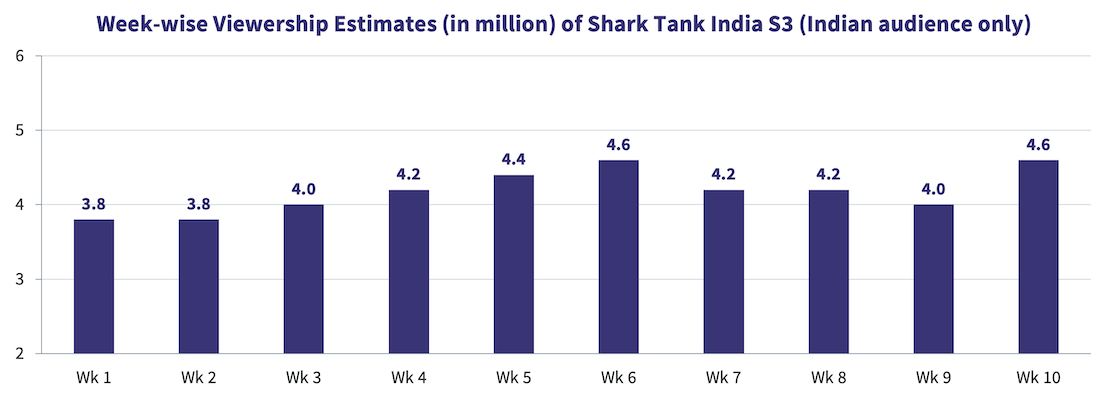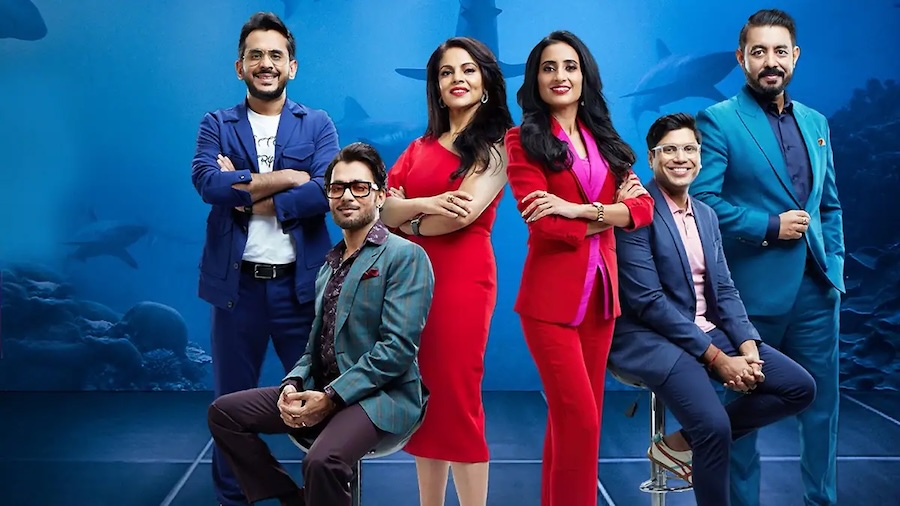


By Sanket Kulkarni, Shreya Ramakrishnan
The reality shows genre has been on an ascendancy in the Indian streaming space. Earlier this week, the third season of Shark Tank India (Sony LIV) completed its successful run over 52 episodes. The first two seasons were aired on television (Sony Entertainment Television) too. TV ratings were hard to come by, which is why Sony’s decision to launch the third season as an ‘OTT original’ made a lot of sense.
S3 has done extremely well, with an estimated 12.5 million Indians watching at least one episode as per Ormax Media’s viewership estimates (see this explainer for the methodology). This makes Shark Tank India S3 the most-watched Hindi language SVOD non-fiction show, a record Kapil Sharma’s new show on Netflix will be hoping to break in due course.
Over the 10 weeks of its run, the show garnered 4-5 million audience who watched 1+ episode in the week, which means that an average audience member watched the show in about three weeks, and at a modest assumption of just two episodes per week, the total Shark Tank India S3 consumption can be estimated at about 80 million episode views. Add to it the clips on YouTube, social media and all the memes, and we have a thriving property, which will only get bigger with each passing season.
Admirably, the show witnessed week-on-week growth in its estimated viewership, as seen in the chart below. This is a rarity for non-fiction content, on both OTT and TV, where viewership typically peaks in the first week or two, when trials are the highest. This consistent performance is also reflected in the show’s strong Ormax Power Rating (OPR) of 63, which is the highest across all Hindi non-fiction shows (SVOD or AVOD) on OTT till date.

Over the last few years, reality shows on OTT in India have tried to grow on the back of the foundation that the TV & AVOD ecosystem, and the influencer economy, had already created (read this Jan 2024 analysis for more). In this aspect, Shark Tank India stands out as a unique offering. In fact, the show has created a sub-genre of its own, with several me-too variants across platforms, including YouTube, being launched over the last two years.
By choosing to go on OTT, the show has finally found its ‘product-market fit’, a term that’s hard to miss in a typical Shark Tank India episode. Gradual evolution of the show over three seasons, coupled with strategic programming decisions and marketing initiatives, has helped it resonate well with digital audiences.
Sometimes, new ideas can come too early, or too late. But Shark Tank India could not have been better-timed. In September 2014, PM Modi launched the ‘Make In India’ campaign, putting Indian businesses and entrepreneurs in the forefront. This entrepreneurial revolution has resulted in heightened interest to know more about start-ups, and hear about their stories. This interest also comes with an element of national identity attached to it. Make In India has a strong subtext of feeling proud to be an Indian. While Shark Tank India is not patriotic in a chest-thumping ‘how’s-the-josh’ way, seeing Indians, often from humble backgrounds, displaying their innovation capabilities on the show, manages to evoke this emotion.
India has traditionally been seen as a risk-averse, job-seeking economy. The younger generation, however, believes in doing things on their own terms, and owning their success. Shark Tank India is a show about job creators, about people who have chosen to control the narrative of their success, which is aspirational for many viewers, especially the core OTT demographic.
Much as it is well-timed, the show owes its success equally to its superior execution. Over the three seasons, the quality of pitches has improved, owing to the general awareness, and learnings from previous seasons, as if the show is self-fueling its own growth. Incorporating narrative elements that make the show more accessible to a broader audience, such as explaining business terms, and featuring sharks who can speak fluently in Hindi, has enhanced the show’s inclusivity. One of the primary challenges in a business show is to provide knowledge without alienating the ordinary audience who’s not interested in too much depth on the subject. Shark Tank India does two things to address this: repetition of business terms across episodes, and simplified explanation of terms by the judges. Through the course of a few episodes, you become accustomed to ‘jargon’ like go-to-market strategy, unit economics, burn, PAT, and of course, product-market fit.
The show acknowledges that we live in an era of short attention spans and impatience, where we prefer reels, and want our groceries delivered in 10 minutes. The format of three pitches per episode, with limited continuity, makes it an even better fit from the perspective of digital consumption habits. Thanks to sharp editing, each pitch is a mini-event of sorts, full of information and entertainment in equal measure. Even though each episode is nearly an hour long, you never quite feel the length.
While the format is that of a business reality show, Shark Tank India is essentially a collection of human stories, told via the businesses they run. Unlike many other shows, human stories on Shark Tank India are less about evoking sympathy, and instead focus on celebration of their achievements. It further helps that most stories are about middle-class entrepreneurs trying to start something of their own with limited resources, with their friends or their family being their co-founders.
It's hard to write about the success of Shark Tank India and not mention its judges. In general, Indian audiences have two major expectations from judges on a reality show. They are expected to be credible subject-matter experts, and are expected to infuse the show with entertaining moments via their dynamic, with each other and with the contestants. In case of Shark Tank India, the former is the easier ask. But it’s ability of the judges on the show to deliver on the latter (entertaining moments) has been a pleasant surprise, busting the stereotype that CEOs and MDs are generally boring businesspeople. The 5-6 key judges, who have featured prominently across seasons now, are distinct from each other, and yet, form a collective that’s highly endearing and enjoyable. In a format that may seem like an antithesis to the comedy genre at first glance, this is a remarkable accomplishment. The show rates a high 60 on Mind Fresh, one of the 11 Ormax Power Rating (OPR) drivers for reality shows.

We are only a quarter into 2024, but it is safe to say that Shark Tank India S3 will be one of the memorable success stories of the year when it ends. And deservedly so!

From CTV to Micro Dramas: India's fascinating OTT spectrum
The simultaneous rise of Connected TV and Micro Drama audiences in India over the last year highlights how the Indian OTT market is expanding at both the premium and the mass ends simultaneously

Product update: Content testing for the horror genre
Based on our accumulated audience insights, we are introducing genre-specific drivers for horror films and series in our content testing tools, Ormax Moviescope and Ormax Stream Test

Streaming has a new bias: The male lead
An analysis of 338 Hindi fiction originals since 2022 highlights a growing imbalance in the Indian streaming ecosystem, with male-led stories steadily taking over
Subscribe to stay updated with our latest insights
We use cookies to improve your experience on this site. To find out more, read our Privacy Policy